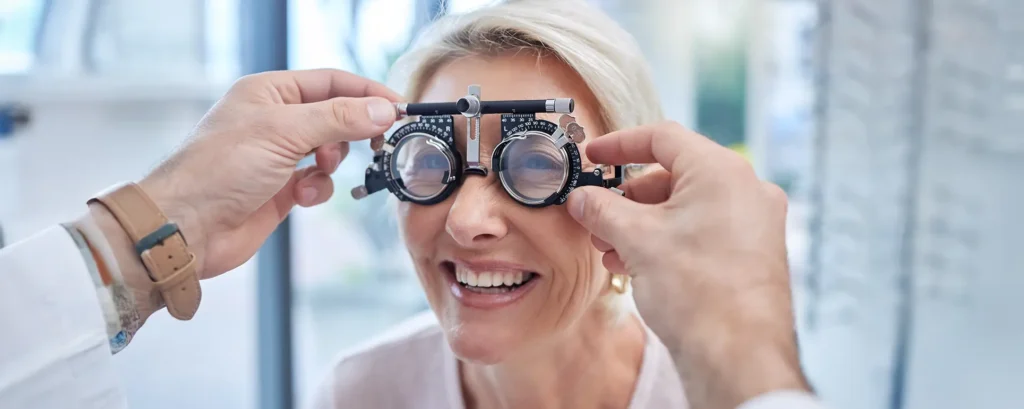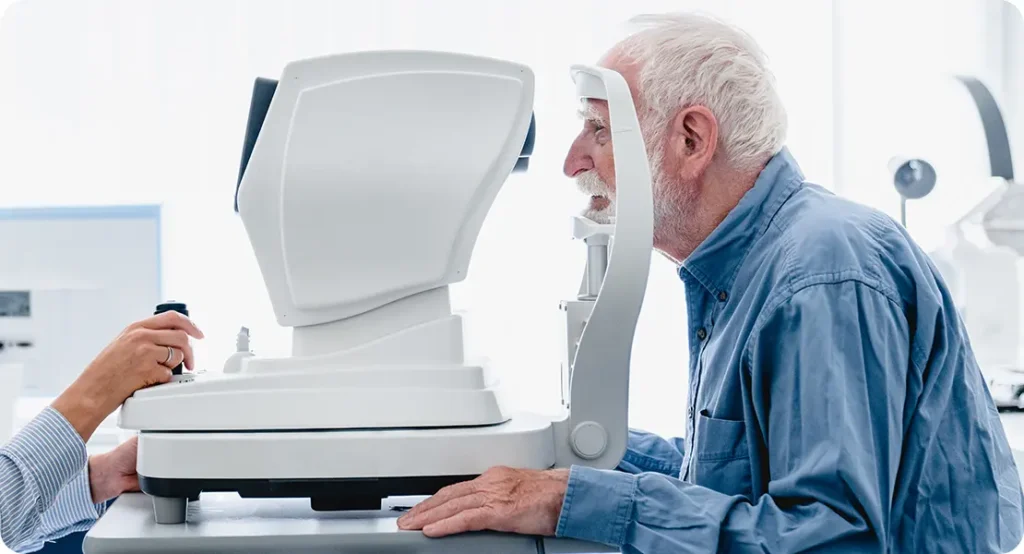When most people hear the word cataract, they think of a cloudy lens that gradually blurs vision and is then removed with routine surgery. While this is accurate for the majority of cases, not all cataracts are the same. Some are far more complex, pose greater risks during surgery, and can lead to more serious visual problems if not managed carefully. So, what is the most serious type of cataract? In this article, we’ll explore the different kinds of cataracts, identify those considered most dangerous, and explain how surgeons today manage even the most challenging cases.
Understanding Cataracts: The Basics
A cataract simply means a loss of lens transparency. The lens, sitting just behind your iris and pupil, focuses light onto the retina so you can see clearly. Over time, changes in lens proteins cause the lens to lose its clarity, leading to blurred, misty, or dimmed vision.
Cataracts are incredibly common — almost everyone will develop one if they live long enough. However, there are several types, and their seriousness depends on factors such as their location in the lens, how quickly they progress, and the risks they pose during surgery.
Most cataracts are age-related and progress slowly, but others may be linked to trauma, systemic disease, medications, or genetics. Some remain mild for years, while others threaten sight more aggressively.
Common Types of Cataracts (Generally Less Risky)

Let’s quickly review the forms you’ll often hear about in routine practice. These types are common and, while they do affect vision, they’re usually less dangerous compared to the more complex varieties.
Nuclear Sclerotic Cataract
This is the classic age-related cataract. It affects the central “nucleus” of the lens, gradually making it yellow or even brown. Vision becomes blurry, colours seem duller, and night driving is especially difficult. Although it worsens slowly, surgery is typically straightforward and safe.
Cortical Cataract
This type begins in the outer part of the lens (the cortex) and progresses inward in wedge-shaped “spokes.” It often causes glare and halos, particularly at night. Again, while bothersome, cortical cataracts are normally manageable and carry a standard surgical risk.
Posterior Subcapsular Cataract
Here, the clouding develops at the back of the lens, just in front of the capsule. Even small opacities can disrupt reading and create glare in bright light. Posterior subcapsular cataracts often progress faster than nuclear or cortical cataracts, but they remain surgically treatable with generally good outcomes.
Congenital Cataracts (non-polar types)
Some babies are born with lens opacities. Many are small and stable, sometimes not requiring immediate surgery. However, if they interfere with vision, they can cause amblyopia (lazy eye), so early treatment may be needed. Although important, these cases are not usually considered “the most serious.”
What Makes a Cataract Serious?
Not all cataracts are equal in terms of risk. A cataract is considered more serious when:
- It is closely associated with a fragile or abnormal lens capsule.
- It carries a higher likelihood of surgical complications, such as capsule rupture.
- It progresses quickly, threatening sight in a short period of time.
- It arises from trauma or systemic disease that also damages other eye structures.
- It complicates visual outcomes or requires advanced surgical techniques.
With those criteria in mind, two forms stand out as especially serious: posterior polar cataracts and traumatic cataracts. Let’s look at them in more detail.
Posterior Polar Cataracts: A High-Risk Challenge

What They Are
Posterior polar cataracts are located right at the back of the lens, in the central “polar” region. They are often congenital, meaning present from birth, and they can run in families. The key feature is that they are tightly stuck to the posterior capsule — the thin, transparent membrane that encloses the back of the lens.
The catch? This membrane is already the most delicate part of the lens capsule. In posterior polar cataracts, it is frequently weak, abnormally thin, or even partially missing.
Why They’re So Serious
Surgery for posterior polar cataracts is among the riskiest in cataract practice. Because the opacity is fused to the capsule, attempts to separate it can easily cause the capsule to rupture. Once that happens, pieces of the cataract can drop into the vitreous cavity at the back of the eye, leading to complications and requiring additional surgery such as a vitrectomy.
Even in the most skilled hands, capsule rupture is far more common in posterior polar cataract surgery compared to routine cataracts. This makes them one of the most serious types, not necessarily because they cause the worst vision loss, but because they carry the greatest surgical danger.
How They’re Managed Today
Thankfully, surgical strategies have evolved. Modern surgeons often avoid certain fluid techniques that might stress the capsule, and they may use femtosecond laser or other advanced tools to reduce risk. Meticulous planning, gentle handling, and intraoperative judgement are essential. With these precautions, many patients still achieve excellent outcomes.
Traumatic Cataracts: Unpredictable and Dangerous
What They Are
A traumatic cataract is caused by injury to the eye. Trauma may be blunt (like a ball hitting the eye), penetrating (a sharp object piercing the eye), or related to radiation, chemicals, or electric shock. The impact can directly damage the lens and surrounding tissues, triggering cataract formation.
Why They’re So Serious
Unlike age-related cataracts, traumatic cataracts don’t come alone. They are often accompanied by other injuries — such as a torn capsule, damaged zonules (the fibres that hold the lens in place), bleeding inside the eye, or even retinal tears. This makes surgery highly unpredictable.
Because the structural support of the lens may be weakened, standard techniques sometimes won’t work. Surgeons may need to use capsule hooks, rings, or even implant a lens in a non-standard location.
The seriousness here lies in the complexity: you’re not just dealing with a cloudy lens, but a whole cascade of trauma-related issues that complicate safe removal and visual recovery.
How They’re Managed Today
Advances in imaging (like ultrasound biomicroscopy) and surgical planning mean traumatic cataracts can often be handled effectively. Surgeons prepare for unexpected findings, and specialised equipment is used to stabilise the eye. Outcomes vary, depending on the severity of trauma, but many patients still regain useful vision.
Other Cataracts That Can Be Considered Serious
While posterior polar and traumatic cataracts take the top spots, other types can also present serious challenges:
- Mature or hypermature cataracts: These are advanced cataracts where the entire lens becomes opaque. In some cases, the lens can leak protein, causing inflammation or glaucoma.
- Secondary cataracts from systemic disease: For example, cataracts linked to diabetes or prolonged corticosteroid use may progress more rapidly and complicate overall eye health.
- Radiation cataracts: Seen in patients exposed to radiation (such as cancer treatment), these can be aggressive and appear earlier than expected.
Each of these scenarios brings additional risks, but they generally remain more manageable than the classic “serious” cataracts mentioned above.
Why Early Diagnosis Matters
One of the best ways to reduce the risks associated with cataracts is to diagnose them early. When you catch them before they become advanced or complicated, surgery is more straightforward, visual outcomes are better, and risks are lower.
Eye checks are especially important if you have risk factors such as diabetes, a history of eye injury, or long-term steroid use. Regular monitoring ensures that if a more complex cataract begins to develop, it can be managed at the right time.
FAQ: What You Need to Know About Serious Cataracts
1. Are posterior polar cataracts always dangerous?
Posterior polar cataracts are considered dangerous because of their direct connection to the fragile posterior capsule. This makes surgery far more delicate and prone to complications such as capsule rupture. However, “dangerous” doesn’t mean untreatable. With careful planning, specialised techniques, and an experienced surgeon, most patients still achieve excellent vision afterwards. The key is that they require more caution compared to standard cataracts.
2. Can traumatic cataracts be prevented?
While you can’t prevent every accident, many traumatic cataracts are avoidable with proper protection. Injuries at work, during sports, or in DIY activities are among the leading causes, and these can often be prevented by wearing safety goggles or protective gear. Trauma from sharp objects or blunt impact can instantly damage the lens and cause a cataract, so protecting your eyes in risky situations is one of the most effective ways to reduce your risk.
3. Do all traumatic cataracts need immediate surgery?
Not all traumatic cataracts require immediate removal. In some cases, if the injury is mild and the cataract is not significantly impairing vision, surgeons may choose to monitor the eye over time. But if the cataract is causing rapid deterioration, or if it’s associated with other injuries like a torn capsule or retinal damage, early surgery may be recommended. The timing depends heavily on both the extent of trauma and the impact on your day-to-day life.
4. How do I know if I have a posterior polar cataract?
You won’t be able to diagnose a posterior polar cataract yourself. The only way to confirm it is through a detailed eye examination with a specialist using a slit-lamp microscope and, in some cases, additional imaging like OCT scans. These tools allow the surgeon to see where the cataract is located in relation to the capsule. If you’re told you have a posterior polar cataract, it usually means extra care will be taken during surgery.
5. Are posterior subcapsular cataracts also serious?
Posterior subcapsular cataracts can be visually troublesome because they sit right in the path of incoming light. Even small ones can make reading difficult and cause significant glare. But from a surgical perspective, they don’t carry the same high risk as posterior polar cataracts. They can be removed relatively safely with standard cataract surgery techniques, although they tend to progress more quickly than other types and often require earlier surgery.
6. What happens if the capsule ruptures during surgery?
If the posterior capsule ruptures during surgery, it complicates the procedure but doesn’t necessarily mean failure. Surgeons have techniques to manage this situation, such as performing a limited vitrectomy to remove lens fragments and adjusting how and where they place the artificial lens. Recovery might be slower, and there may be a slightly higher risk of complications like retinal detachment, but with modern tools and experienced hands, many patients still end up with good visual outcomes.
7. Do serious cataracts always lead to blindness if untreated?
Serious cataracts don’t always lead to total blindness, but they can cause severe vision loss over time. For example, a posterior polar cataract may gradually reduce central clarity, while a hypermature cataract can cause inflammation or secondary glaucoma if neglected. Left untreated, these complications can eventually threaten sight completely. This is why regular monitoring and timely surgery are so important to avoid unnecessary vision loss.
8. Can children develop posterior polar cataracts?
Yes, children can develop posterior polar cataracts, and many are actually present from birth as a congenital condition. In children, these cataracts carry added urgency because prolonged visual disruption can lead to amblyopia (lazy eye). That means surgery might be needed earlier in life, even when operating carries greater risks. Paediatric eye specialists carefully weigh the timing to protect long-term vision while minimising surgical complications.
9. Do modern surgical tools make serious cataracts safer to treat?
Modern surgical tools have significantly reduced the risks associated with complex cataracts. Phacoemulsification machines with advanced fluidics, femtosecond lasers, and vitreoretinal support devices all help surgeons handle delicate cases more safely. While they don’t completely eliminate the risk of complications, these tools give surgeons greater control and flexibility when things don’t go as planned. This means outcomes today are far better than they were even a couple of decades ago.
10. What should I ask my surgeon if I’m told I have a serious cataract?
If you’ve been told your cataract is complex, it’s important to ask your surgeon about their experience with these specific cases. Ask how they plan to handle risks like capsule rupture, what backup strategies they have if complications arise, and what you can realistically expect in terms of vision afterwards. A good surgeon will be open about the potential challenges while also reassuring you about the safeguards in place to maximise your outcome.
Final Thoughts
So, when we ask what the most serious type of cataract is, the answer usually points towards posterior polar cataracts and traumatic cataracts. These forms carry the highest risk because of their connection to fragile or damaged eye structures and the increased chance of complications during surgery. That said, serious doesn’t mean hopeless. With the right expertise, advanced techniques, and careful planning, patients with these cataracts can still achieve excellent visual results.
If you’ve been told you may have a complex cataract, it’s natural to feel anxious about what lies ahead. The important thing to remember is that modern cataract surgery has advanced to a point where even challenging cases can often be managed safely. The key is choosing an experienced surgeon and making sure you understand the specific risks and strategies involved in your care.
Our advice is not to wait until your cataract causes major disruption to your quality of life. Early assessment gives your surgeon more control over timing and technique, reducing unnecessary complications. The sooner you know what you’re dealing with, the better your outcome is likely to be.
If you’re considering treatment and would like to explore your options in more detail, you can book a consultation with us at the London Cataract Centre and speak directly with our team. Taking that first step could bring you closer to clearer, more confident vision — even if your cataract is one of the more serious types.
References
- Vasavada, A.R. and Singh, R., 2017. Managing the posterior polar cataract: An update. Indian Journal of Ophthalmology, 65(12), pp.1350-1358. Available at: https://journals.lww.com/ijo/fulltext/2017/65120/managing_the_posterior_polar_cataract__an_update.14.aspx [Accessed 30 September 2025].
- Osher, R.H., Yu, B.C. and Koch, D.D., 1990. Posterior polar cataracts: a predisposition to intraoperative posterior capsular rupture. Journal of Cataract & Refractive Surgery, 16(2), pp.157-162. Available at: https://pubmed.ncbi.nlm.nih.gov/2330218/ [Accessed 30 September 2025].
- Shrestha, J.B., Pokhrel, P.K., Shrestha, S.K. and Pradhananga, C.L., 2011. Posterior polar cataract: predisposing factors, intraoperative complications, and visual outcomes. Saudi Journal of Ophthalmology, 25(3), pp.233-237. Available at: https://www.sciencedirect.com/science/article/pii/S1319453411000609 [Accessed 30 September 2025].

